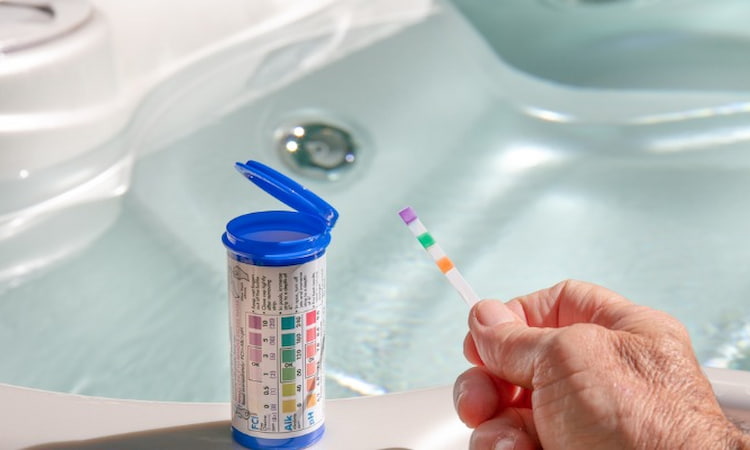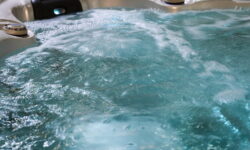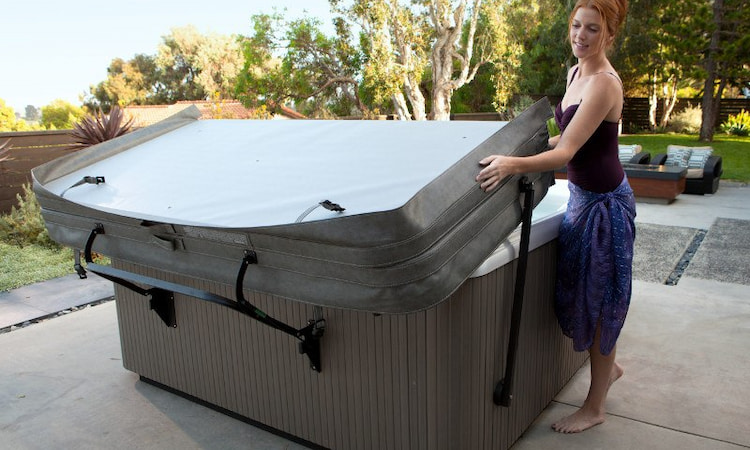You’re about to dive into the world of hot tub maintenance. Don’t worry, it’s not as daunting as it seems. To test hot tub water, you’ll need a water testing kit, commonly available at pool supply stores.
Fill the vials in the testing kit with water from your hot tub. Then, add the provided reagents to the water sample. The water will change color based on the chemicals present in your hot tub, and you can compare these colors to the chart included in your kit to understand the levels of different chemicals in your water.
This guide will walk you through the process, explain the importance of pH levels and sanitizer, and give you a step-by-step routine for testing your hot tub water. Let’s get started!

Quick Navigation
Understanding Hot Tub Water Chemistry
Before you dive into the process of testing your hot tub’s water, it’s crucial for you to understand the chemistry behind it.
Hot tub water chemistry involves a delicate balance. It’s not just about keeping the water clear; it’s also about ensuring it’s safe for everyone who dips in.
The main elements you’ll be testing for are pH, alkalinity, and sanitizer levels. The pH level measures how acidic or basic the water is. If it’s too high or too low, it can lead to skin irritation and even damage your hot tub equipment.
Alkalinity acts as a buffer for the pH level, helping to keep it stable. It’s important to monitor these two closely as they directly influence each other.
Lastly, sanitizer levels, such as chlorine or bromine, are crucial for keeping your hot tub free from harmful bacteria and algae. Too much can be harsh on the skin and eyes, while too little can lead to unsanitary conditions.
Necessary Tools for Water Testing
To properly test your hot tub’s water, you’ll need a few essential tools. These tools will ensure that your hot tub is safe, clean, and optimal for use at all times. Here’s what you’ll need:
- A water testing kit: this is the most critical tool. It’ll allow you to test for pH levels, alkalinity, and sanitizer levels. It’s a simple, straightforward way to keep tabs on your water’s health.
- A thermometer: hot tub water should be between 100 and 102 degrees Fahrenheit. A solid, reliable thermometer helps you maintain this.
- Test strips: they offer a quick way to check your hot tub’s water chemistry. Just dip and compare to the color chart.
- A water hardness test kit: hard water can damage your hot tub. This kit allows you to measure water hardness and take action if necessary.
- Spa shock: if your water tests reveal high levels of contaminants, a spa shock treatment can restore water balance.
The Importance of pH Levels
With your testing kit in hand, it’s crucial to understand the importance of pH levels in your hot tub’s water.

The pH level measures how acidic or basic your water is on a scale of 0 to 14. A pH level of 7 is neutral, below 7 is acidic, and above 7 is basic. For a hot tub, you’d aim for a pH level between 7.2 and 7.8.
Why does this matter? If your hot tub’s water is too acidic, it can cause corrosion of your tub’s equipment and surfaces. This can lead to costly repairs or replacements. On the other hand, if the water’s too basic, it can lead to scale formation, which can clog your filters and reduce the effectiveness of your sanitizers.
Moreover, incorrect pH levels can cause skin and eye irritation, making your hot tub experience less enjoyable. It can also influence the water’s clarity and odor. Proper pH balance enhances sanitizer efficiency, ensuring a healthy, clean, and inviting hot tub.
Sanitizer Levels: What to Know
Just as you’ve learned about balancing pH levels, it’s equally essential to understand your hot tub’s sanitizer levels.
These levels are crucial in keeping the water clean and free from harmful microorganisms that can pose health risks.
You need to test the sanitizer levels regularly. And here’s why:
- Health Safety: high sanitizer levels can irritate your skin and eyes, while low levels won’t kill bacteria effectively.
- Comfort: proper levels ensure the water feels and smells fresh.
- Longevity of your hot tub: imbalanced levels can damage your hot tub’s parts.
- Ease of maintenance: regular checks make it easier to spot and address issues.
- Peace of mind: knowing your hot tub water is safe gives you one less thing to worry about.
There are different types of sanitizers you can use, including chlorine and bromine. Each has its pros and cons, so you’ll need to decide which works best for you.
Step-By-Step Hot Tub Water Testing
Maintaining your hot tub’s sanitizer levels involves regular water testing, a process we’ll now break down into easy-to-follow steps. Remember, precise, consistent testing ensures your hot tub’s longevity and your health.
- First, obtain a quality test kit. Ensure it tests for pH, alkalinity, sanitizer levels, and calcium hardness.
- Now, let’s start testing. Begin by rinsing the test tube or strip with hot tub water to remove any residual chemicals.
- Next, fill it with water up to the marked line, ensuring it’s about elbow-deep for an accurate reading.
- Next, add the appropriate reagent from your test kit. Gently swirl the mixture, then wait for the color to change. Compare this color to the chart provided in the kit. This will give you the current levels of the water’s chemical composition.
If these levels are outside the ideal range, you’ll need to adjust them. This may involve adding chemicals to increase or decrease certain levels. Always follow the manufacturer’s instructions when adding these substances.
Frequently Asked Questions
You should test your hot tub water at least twice a week. It’s important to maintain a healthy balance of chemicals for your safety and the longevity of your tub. Don’t neglect this crucial task.
Absolutely. If you’re noticing cloudy water, unusual odors, or skin irritation after use, it’s likely time to test your hot tub water. These signs indicate potential chemical imbalances that require your attention.
If you don’t regularly test your hot tub water, you’re risking bacterial infections, skin and eye irritations, and respiratory issues due to chemical imbalances. It’s essential to maintain proper water hygiene for safety.
Yes, you can use the same water testing kit for your hot tub that you use for your swimming pool. Both test for pH, alkalinity, and sanitizer levels. However, hot tubs need more frequent testing.
If your hot tub water test results aren’t within normal range, you should adjust the chemical balance. Consult your hot tub’s manual or a professional for specific instructions. Always retest after making adjustments.
Conclusion
Understanding your hot tub’s water chemistry is crucial to keeping it safe and enjoyable. You’ve learned the importance of pH and sanitizer levels, and the tools necessary for water testing.
Following the step-by-step guide, you’re now equipped to maintain your hot tub’s water quality. Remember, regular testing and timely adjustments will ensure a healthy, clean hot tub, providing endless relaxation and fun.


![How Many Gallons of Water in a Hot Tub? [Different Sized Hot Tubs] how many gallons of water in a hot tub](https://hottubtales.com/wp-content/uploads/2023/10/how-many-gallons-of-water-in-a-hot-tub.jpg)
![Is Yellow Hot Tub Water Safe? [& Treatment Options] is yellow water in hot tub safe](https://hottubtales.com/wp-content/uploads/2023/10/is-yellow-water-in-hot-tub-safe-250x150.jpg)


